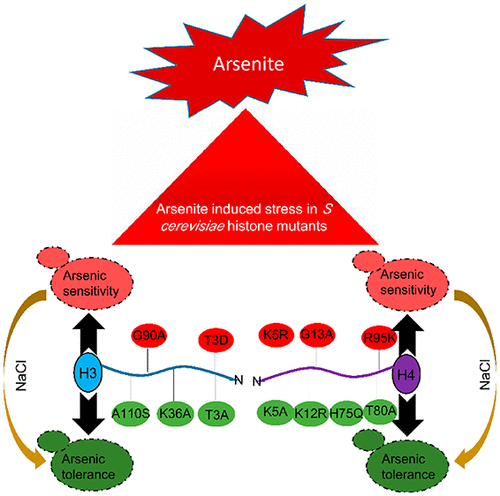当前位置:
X-MOL 学术
›
Chem. Res. Toxicol.
›
论文详情
Our official English website, www.x-mol.net, welcomes your
feedback! (Note: you will need to create a separate account there.)
Identification of Histone H3 and H4 Amino Acid Residues Important for the Regulation of Arsenite Stress Signaling in Saccharomyces cerevisiae.
Chemical Research in Toxicology ( IF 3.7 ) Pub Date : 2020-02-07 , DOI: 10.1021/acs.chemrestox.9b00471 Pilendra Kumar Thakre 1 , Upendarrao Golla 2 , Ashis Biswas 3 , Raghuvir Singh Tomar 1
Chemical Research in Toxicology ( IF 3.7 ) Pub Date : 2020-02-07 , DOI: 10.1021/acs.chemrestox.9b00471 Pilendra Kumar Thakre 1 , Upendarrao Golla 2 , Ashis Biswas 3 , Raghuvir Singh Tomar 1
Affiliation

|
Arsenic is an environmental carcinogen that causes many diseases in humans, including cancers and organ failures, affecting millions of people in the world. Arsenic trioxide is a drug used for the treatment of acute promyelocytic leukemia (APL). In the present study, we screened the synthetic histone H3 and H4 library in the presence of arsenite to understand the role of histone residues in arsenic toxicity. We identified residues of histone H3 and H4 crucial for arsenite stress response. The residues H3T3, H3G90, H4K5, H4G13, and H4R95 are required for the activation of Hog1 kinase in response to arsenite exposure. We showed that a reduced level of Hog1 activation increases the intracellular arsenic content in these histone mutants through the Fps1 channel. We have also noticed the reduced expression of ACR3 exporter in the mutants. The growth defect of mutants caused by arsenite exposure was suppressed in hyperosmotic conditions, in a higher concentration of glucose, and upon deletion of the FPS1 gene. The arsenite sensitive histone mutants also showed a lack of H3K4 methylation and reduced H4K16 acetylation. Altogether, we have identified the key residues in histone H3 and H4 proteins important for the regulation of Hog1 signaling, Fps1 activity, and ACR3 expression during arsenite stress.
中文翻译:

组蛋白H3和H4氨基酸残基的鉴定对酿酒酵母中砷胁迫信号的调控很重要。
砷是一种环境致癌物,可导致人类多种疾病,包括癌症和器官衰竭,影响着全球数百万人。三氧化二砷是用于治疗急性早幼粒细胞白血病(APL)的药物。在本研究中,我们在亚砷酸盐的存在下筛选了合成的组蛋白H3和H4库,以了解组蛋白残基在砷毒性中的作用。我们确定了组蛋白H3和H4的残留对于亚砷酸盐应力反应至关重要。响应砷暴露,激活Hog1激酶需要残基H3T3,H3G90,H4K5,H4G13和H4R95。我们显示,降低的Hog1激活水平可通过Fps1通道增加这些组蛋白突变体中的细胞内砷含量。我们还注意到突变体中ACR3出口子的表达减少。在高渗条件下,较高的葡萄糖浓度下以及在FPS1基因缺失后,砷暴露引起的突变体生长缺陷得到抑制。对砷敏感的组蛋白突变体还显示出H3K4甲基化的缺乏和H4K16乙酰化的降低。总而言之,我们已经确定了组蛋白H3和H4蛋白中的关键残基,这些残基对于亚砷酸盐胁迫期间Hog1信号传导,Fps1活性和ACR3表达的调节很重要。
更新日期:2020-02-10
中文翻译:

组蛋白H3和H4氨基酸残基的鉴定对酿酒酵母中砷胁迫信号的调控很重要。
砷是一种环境致癌物,可导致人类多种疾病,包括癌症和器官衰竭,影响着全球数百万人。三氧化二砷是用于治疗急性早幼粒细胞白血病(APL)的药物。在本研究中,我们在亚砷酸盐的存在下筛选了合成的组蛋白H3和H4库,以了解组蛋白残基在砷毒性中的作用。我们确定了组蛋白H3和H4的残留对于亚砷酸盐应力反应至关重要。响应砷暴露,激活Hog1激酶需要残基H3T3,H3G90,H4K5,H4G13和H4R95。我们显示,降低的Hog1激活水平可通过Fps1通道增加这些组蛋白突变体中的细胞内砷含量。我们还注意到突变体中ACR3出口子的表达减少。在高渗条件下,较高的葡萄糖浓度下以及在FPS1基因缺失后,砷暴露引起的突变体生长缺陷得到抑制。对砷敏感的组蛋白突变体还显示出H3K4甲基化的缺乏和H4K16乙酰化的降低。总而言之,我们已经确定了组蛋白H3和H4蛋白中的关键残基,这些残基对于亚砷酸盐胁迫期间Hog1信号传导,Fps1活性和ACR3表达的调节很重要。











































 京公网安备 11010802027423号
京公网安备 11010802027423号